A Case Study of Jeffrey Immelt's Leadership and Strategies at GE
VerifiedAdded on 2023/06/12
|22
|6702
|344
Case Study
AI Summary
This case study analyzes Jeffrey Immelt's 16-year tenure as CEO of General Electric, focusing on his leadership strategies, decisions, and their impact on the company. It examines Immelt's response to challenges like the 9/11 attacks and the 2008 financial crisis, his strategic shift towards customer focus, innovation, and organic growth, and his diversification into new markets like infrastructure and healthcare. The analysis includes a VUCA and PESTLE assessment of the 21st-century business environment, a SWOT analysis of GE, and a discussion of organizational changes implemented under Immelt. The study concludes by considering alternative strategies and highlighting key leadership qualities that can be learned from Immelt's experience.
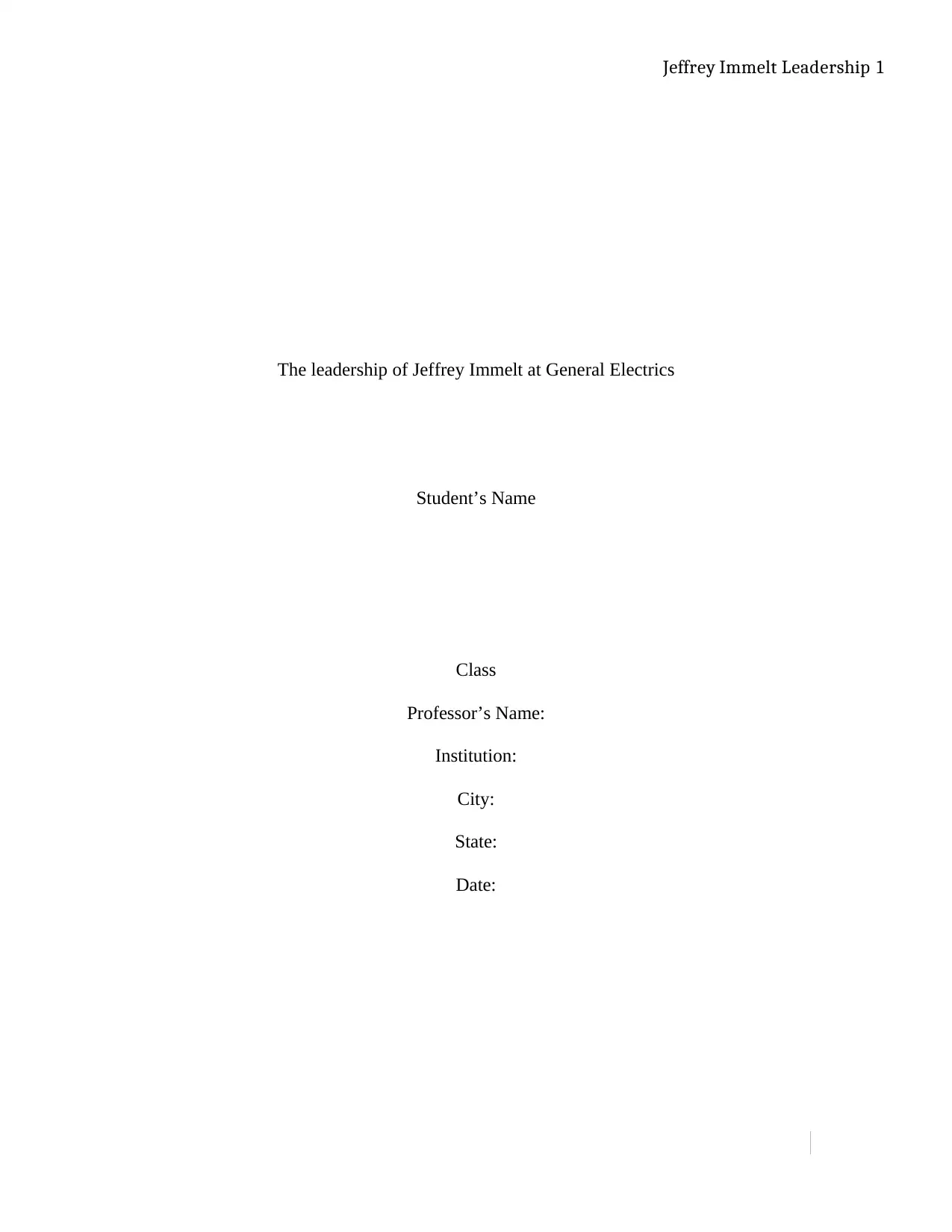
Jeffrey Immelt Leadership 1
The leadership of Jeffrey Immelt at General Electrics
Student’s Name
Class
Professor’s Name:
Institution:
City:
State:
Date:
The leadership of Jeffrey Immelt at General Electrics
Student’s Name
Class
Professor’s Name:
Institution:
City:
State:
Date:
Paraphrase This Document
Need a fresh take? Get an instant paraphrase of this document with our AI Paraphraser
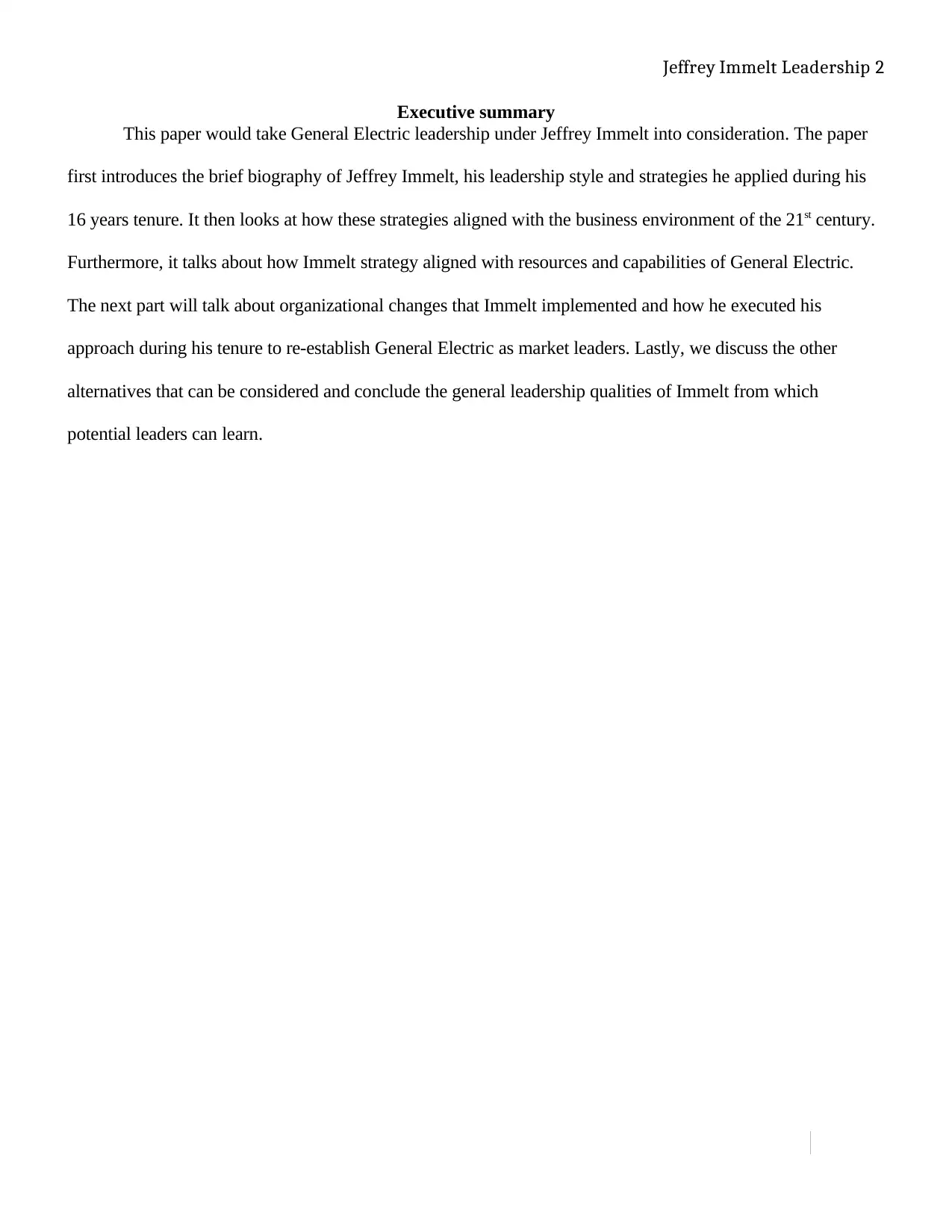
Jeffrey Immelt Leadership 2
Executive summary
This paper would take General Electric leadership under Jeffrey Immelt into consideration. The paper
first introduces the brief biography of Jeffrey Immelt, his leadership style and strategies he applied during his
16 years tenure. It then looks at how these strategies aligned with the business environment of the 21st century.
Furthermore, it talks about how Immelt strategy aligned with resources and capabilities of General Electric.
The next part will talk about organizational changes that Immelt implemented and how he executed his
approach during his tenure to re-establish General Electric as market leaders. Lastly, we discuss the other
alternatives that can be considered and conclude the general leadership qualities of Immelt from which
potential leaders can learn.
Executive summary
This paper would take General Electric leadership under Jeffrey Immelt into consideration. The paper
first introduces the brief biography of Jeffrey Immelt, his leadership style and strategies he applied during his
16 years tenure. It then looks at how these strategies aligned with the business environment of the 21st century.
Furthermore, it talks about how Immelt strategy aligned with resources and capabilities of General Electric.
The next part will talk about organizational changes that Immelt implemented and how he executed his
approach during his tenure to re-establish General Electric as market leaders. Lastly, we discuss the other
alternatives that can be considered and conclude the general leadership qualities of Immelt from which
potential leaders can learn.
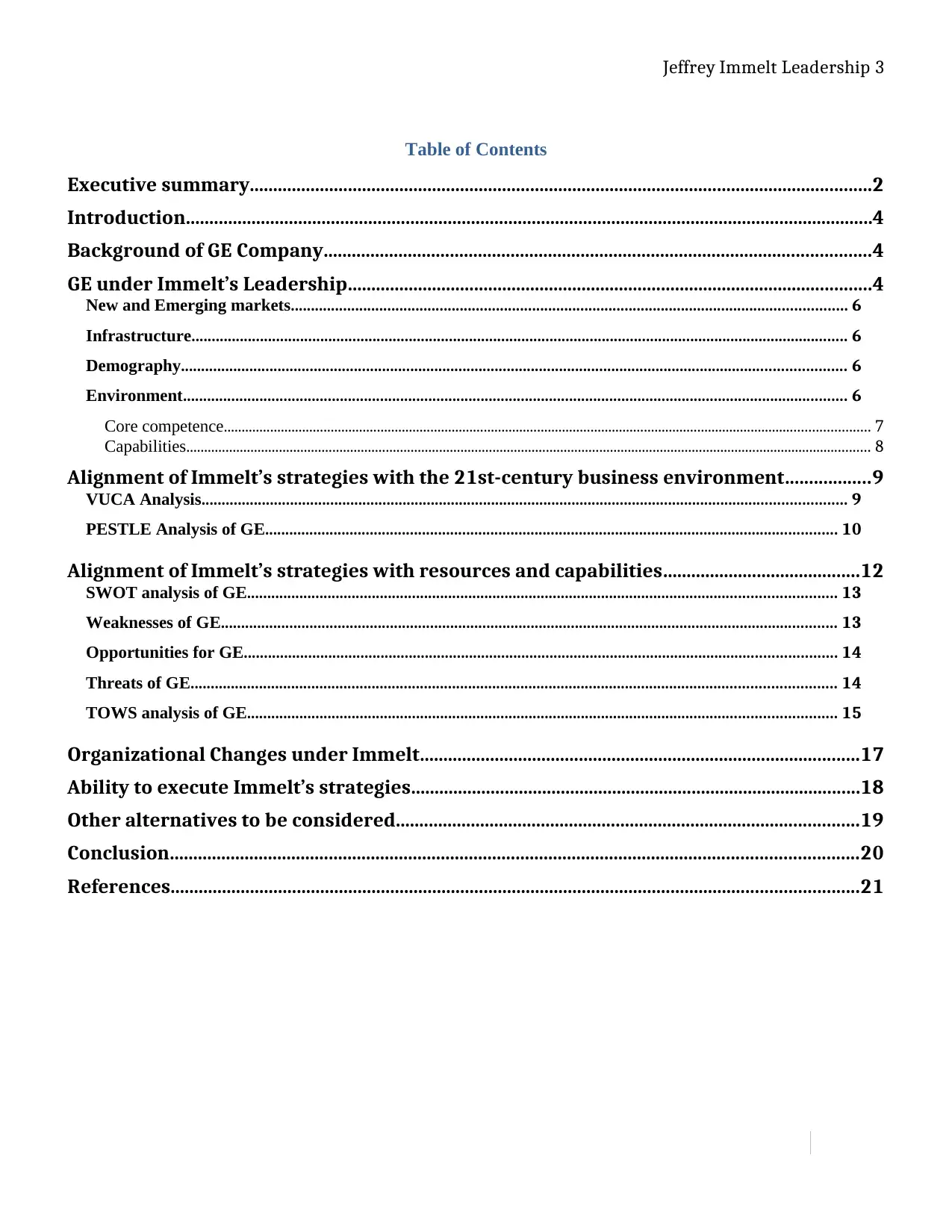
Jeffrey Immelt Leadership 3
Table of Contents
Executive summary.....................................................................................................................................2
Introduction...................................................................................................................................................4
Background of GE Company.....................................................................................................................4
GE under Immelt’s Leadership................................................................................................................4
New and Emerging markets.......................................................................................................................................... 6
Infrastructure................................................................................................................................................................... 6
Demography..................................................................................................................................................................... 6
Environment..................................................................................................................................................................... 6
Core competence..................................................................................................................................................................................... 7
Capabilities................................................................................................................................................................................................ 8
Alignment of Immelt’s strategies with the 21st-century business environment..................9
VUCA Analysis................................................................................................................................................................ 9
PESTLE Analysis of GE.............................................................................................................................................. 10
Alignment of Immelt’s strategies with resources and capabilities..........................................12
SWOT analysis of GE.................................................................................................................................................. 13
Weaknesses of GE......................................................................................................................................................... 13
Opportunities for GE................................................................................................................................................... 14
Threats of GE................................................................................................................................................................ 14
TOWS analysis of GE.................................................................................................................................................. 15
Organizational Changes under Immelt..............................................................................................17
Ability to execute Immelt’s strategies................................................................................................18
Other alternatives to be considered...................................................................................................19
Conclusion...................................................................................................................................................20
References...................................................................................................................................................21
Table of Contents
Executive summary.....................................................................................................................................2
Introduction...................................................................................................................................................4
Background of GE Company.....................................................................................................................4
GE under Immelt’s Leadership................................................................................................................4
New and Emerging markets.......................................................................................................................................... 6
Infrastructure................................................................................................................................................................... 6
Demography..................................................................................................................................................................... 6
Environment..................................................................................................................................................................... 6
Core competence..................................................................................................................................................................................... 7
Capabilities................................................................................................................................................................................................ 8
Alignment of Immelt’s strategies with the 21st-century business environment..................9
VUCA Analysis................................................................................................................................................................ 9
PESTLE Analysis of GE.............................................................................................................................................. 10
Alignment of Immelt’s strategies with resources and capabilities..........................................12
SWOT analysis of GE.................................................................................................................................................. 13
Weaknesses of GE......................................................................................................................................................... 13
Opportunities for GE................................................................................................................................................... 14
Threats of GE................................................................................................................................................................ 14
TOWS analysis of GE.................................................................................................................................................. 15
Organizational Changes under Immelt..............................................................................................17
Ability to execute Immelt’s strategies................................................................................................18
Other alternatives to be considered...................................................................................................19
Conclusion...................................................................................................................................................20
References...................................................................................................................................................21
⊘ This is a preview!⊘
Do you want full access?
Subscribe today to unlock all pages.

Trusted by 1+ million students worldwide
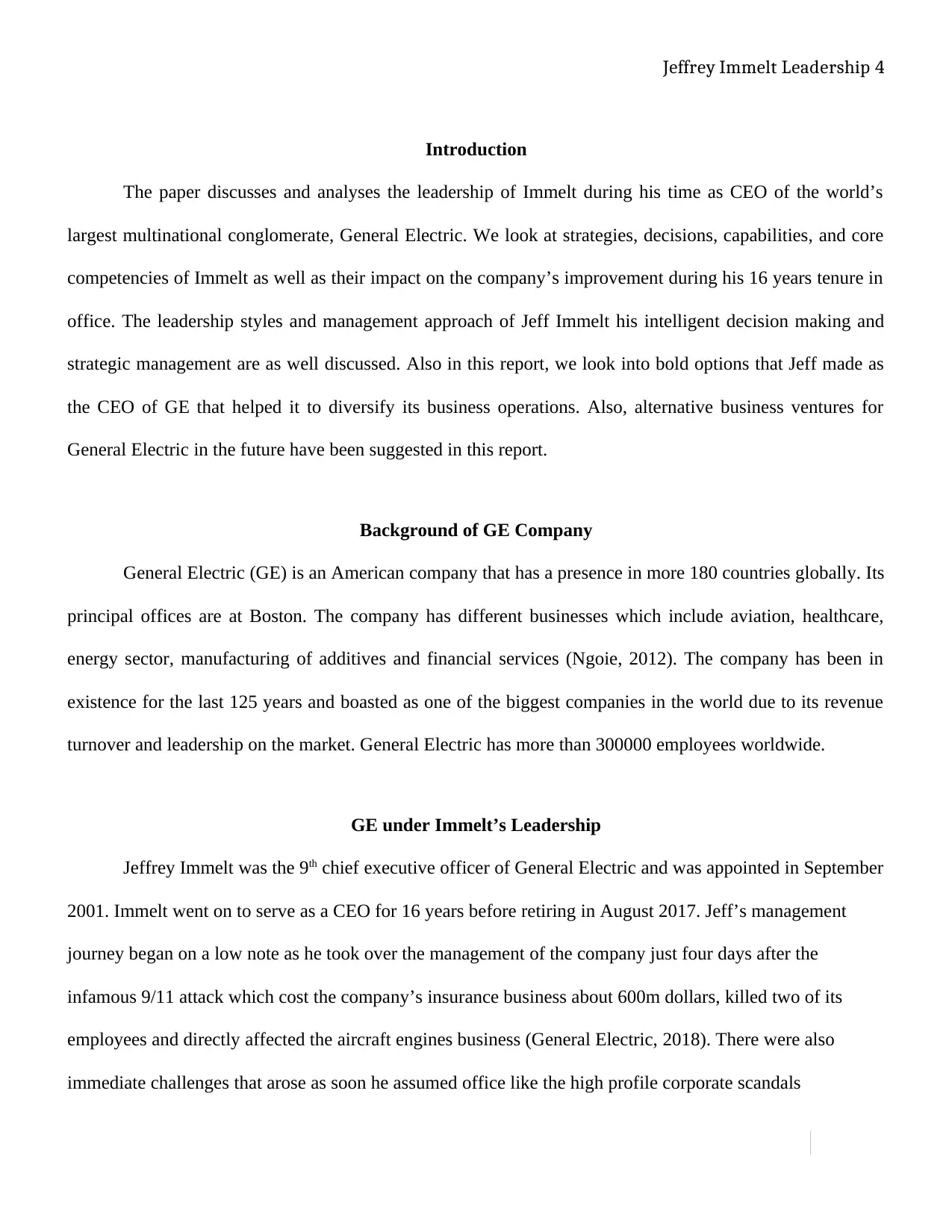
Jeffrey Immelt Leadership 4
Introduction
The paper discusses and analyses the leadership of Immelt during his time as CEO of the world’s
largest multinational conglomerate, General Electric. We look at strategies, decisions, capabilities, and core
competencies of Immelt as well as their impact on the company’s improvement during his 16 years tenure in
office. The leadership styles and management approach of Jeff Immelt his intelligent decision making and
strategic management are as well discussed. Also in this report, we look into bold options that Jeff made as
the CEO of GE that helped it to diversify its business operations. Also, alternative business ventures for
General Electric in the future have been suggested in this report.
Background of GE Company
General Electric (GE) is an American company that has a presence in more 180 countries globally. Its
principal offices are at Boston. The company has different businesses which include aviation, healthcare,
energy sector, manufacturing of additives and financial services (Ngoie, 2012). The company has been in
existence for the last 125 years and boasted as one of the biggest companies in the world due to its revenue
turnover and leadership on the market. General Electric has more than 300000 employees worldwide.
GE under Immelt’s Leadership
Jeffrey Immelt was the 9th chief executive officer of General Electric and was appointed in September
2001. Immelt went on to serve as a CEO for 16 years before retiring in August 2017. Jeff’s management
journey began on a low note as he took over the management of the company just four days after the
infamous 9/11 attack which cost the company’s insurance business about 600m dollars, killed two of its
employees and directly affected the aircraft engines business (General Electric, 2018). There were also
immediate challenges that arose as soon he assumed office like the high profile corporate scandals
Introduction
The paper discusses and analyses the leadership of Immelt during his time as CEO of the world’s
largest multinational conglomerate, General Electric. We look at strategies, decisions, capabilities, and core
competencies of Immelt as well as their impact on the company’s improvement during his 16 years tenure in
office. The leadership styles and management approach of Jeff Immelt his intelligent decision making and
strategic management are as well discussed. Also in this report, we look into bold options that Jeff made as
the CEO of GE that helped it to diversify its business operations. Also, alternative business ventures for
General Electric in the future have been suggested in this report.
Background of GE Company
General Electric (GE) is an American company that has a presence in more 180 countries globally. Its
principal offices are at Boston. The company has different businesses which include aviation, healthcare,
energy sector, manufacturing of additives and financial services (Ngoie, 2012). The company has been in
existence for the last 125 years and boasted as one of the biggest companies in the world due to its revenue
turnover and leadership on the market. General Electric has more than 300000 employees worldwide.
GE under Immelt’s Leadership
Jeffrey Immelt was the 9th chief executive officer of General Electric and was appointed in September
2001. Immelt went on to serve as a CEO for 16 years before retiring in August 2017. Jeff’s management
journey began on a low note as he took over the management of the company just four days after the
infamous 9/11 attack which cost the company’s insurance business about 600m dollars, killed two of its
employees and directly affected the aircraft engines business (General Electric, 2018). There were also
immediate challenges that arose as soon he assumed office like the high profile corporate scandals
Paraphrase This Document
Need a fresh take? Get an instant paraphrase of this document with our AI Paraphraser
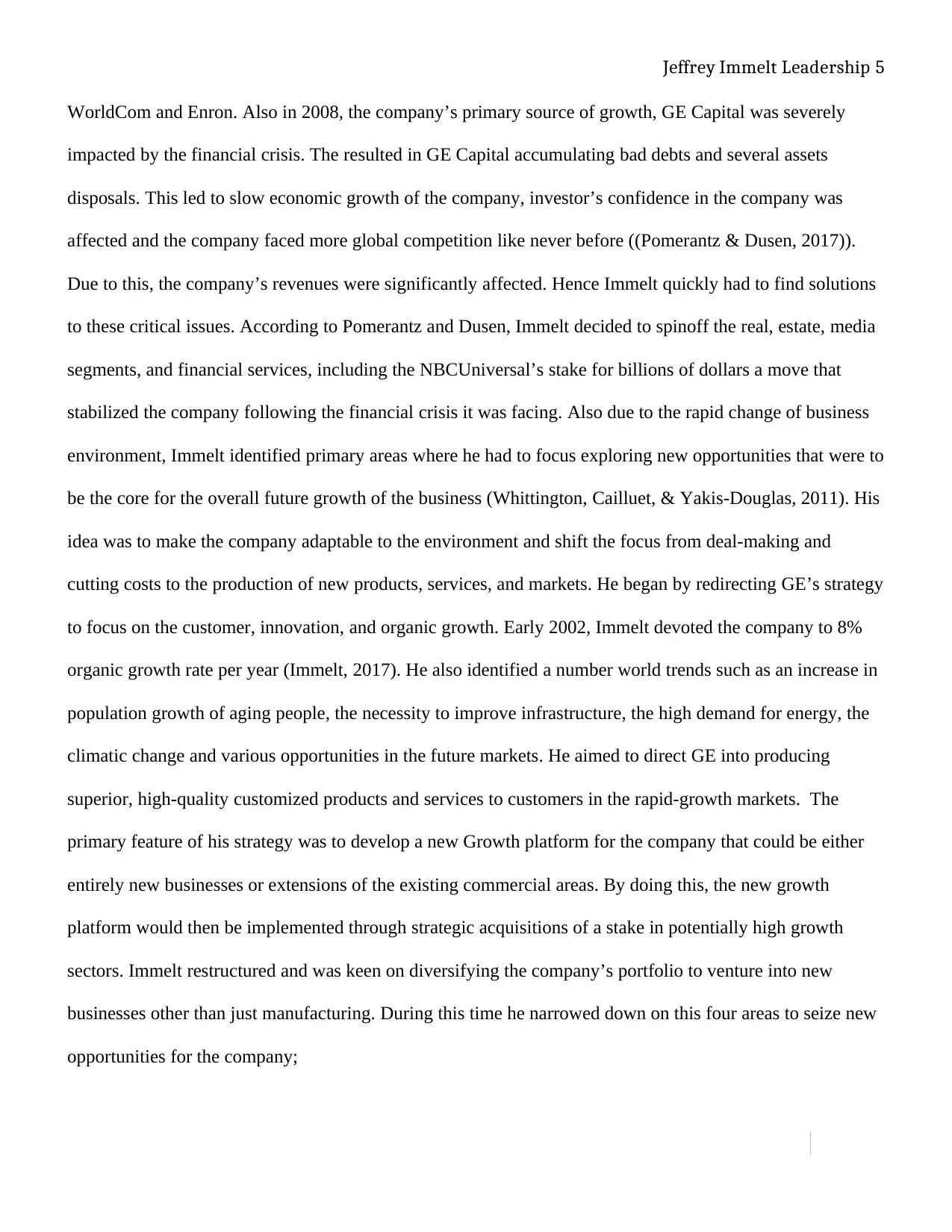
Jeffrey Immelt Leadership 5
WorldCom and Enron. Also in 2008, the company’s primary source of growth, GE Capital was severely
impacted by the financial crisis. The resulted in GE Capital accumulating bad debts and several assets
disposals. This led to slow economic growth of the company, investor’s confidence in the company was
affected and the company faced more global competition like never before ((Pomerantz & Dusen, 2017)).
Due to this, the company’s revenues were significantly affected. Hence Immelt quickly had to find solutions
to these critical issues. According to Pomerantz and Dusen, Immelt decided to spinoff the real, estate, media
segments, and financial services, including the NBCUniversal’s stake for billions of dollars a move that
stabilized the company following the financial crisis it was facing. Also due to the rapid change of business
environment, Immelt identified primary areas where he had to focus exploring new opportunities that were to
be the core for the overall future growth of the business (Whittington, Cailluet, & Yakis-Douglas, 2011). His
idea was to make the company adaptable to the environment and shift the focus from deal-making and
cutting costs to the production of new products, services, and markets. He began by redirecting GE’s strategy
to focus on the customer, innovation, and organic growth. Early 2002, Immelt devoted the company to 8%
organic growth rate per year (Immelt, 2017). He also identified a number world trends such as an increase in
population growth of aging people, the necessity to improve infrastructure, the high demand for energy, the
climatic change and various opportunities in the future markets. He aimed to direct GE into producing
superior, high-quality customized products and services to customers in the rapid-growth markets. The
primary feature of his strategy was to develop a new Growth platform for the company that could be either
entirely new businesses or extensions of the existing commercial areas. By doing this, the new growth
platform would then be implemented through strategic acquisitions of a stake in potentially high growth
sectors. Immelt restructured and was keen on diversifying the company’s portfolio to venture into new
businesses other than just manufacturing. During this time he narrowed down on this four areas to seize new
opportunities for the company;
WorldCom and Enron. Also in 2008, the company’s primary source of growth, GE Capital was severely
impacted by the financial crisis. The resulted in GE Capital accumulating bad debts and several assets
disposals. This led to slow economic growth of the company, investor’s confidence in the company was
affected and the company faced more global competition like never before ((Pomerantz & Dusen, 2017)).
Due to this, the company’s revenues were significantly affected. Hence Immelt quickly had to find solutions
to these critical issues. According to Pomerantz and Dusen, Immelt decided to spinoff the real, estate, media
segments, and financial services, including the NBCUniversal’s stake for billions of dollars a move that
stabilized the company following the financial crisis it was facing. Also due to the rapid change of business
environment, Immelt identified primary areas where he had to focus exploring new opportunities that were to
be the core for the overall future growth of the business (Whittington, Cailluet, & Yakis-Douglas, 2011). His
idea was to make the company adaptable to the environment and shift the focus from deal-making and
cutting costs to the production of new products, services, and markets. He began by redirecting GE’s strategy
to focus on the customer, innovation, and organic growth. Early 2002, Immelt devoted the company to 8%
organic growth rate per year (Immelt, 2017). He also identified a number world trends such as an increase in
population growth of aging people, the necessity to improve infrastructure, the high demand for energy, the
climatic change and various opportunities in the future markets. He aimed to direct GE into producing
superior, high-quality customized products and services to customers in the rapid-growth markets. The
primary feature of his strategy was to develop a new Growth platform for the company that could be either
entirely new businesses or extensions of the existing commercial areas. By doing this, the new growth
platform would then be implemented through strategic acquisitions of a stake in potentially high growth
sectors. Immelt restructured and was keen on diversifying the company’s portfolio to venture into new
businesses other than just manufacturing. During this time he narrowed down on this four areas to seize new
opportunities for the company;
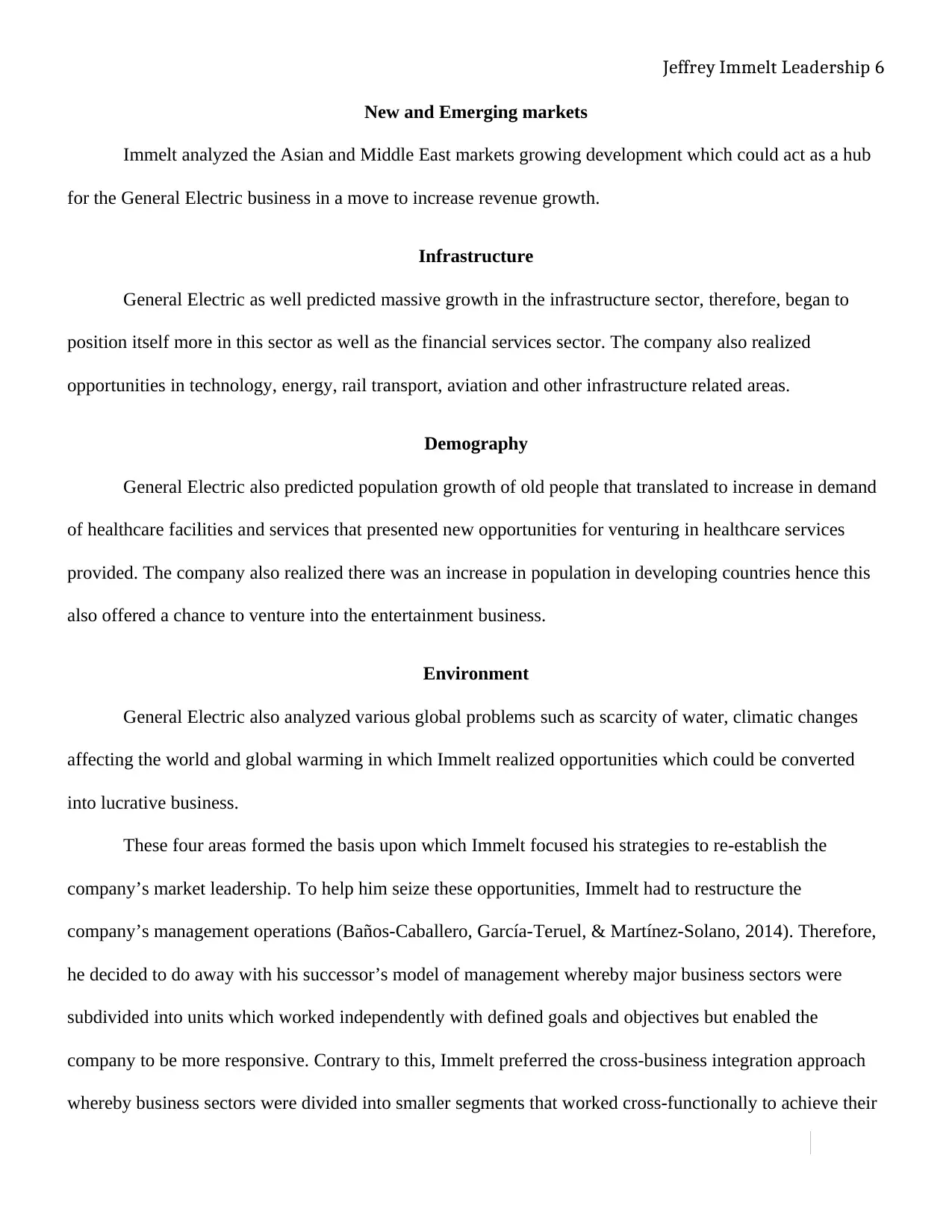
Jeffrey Immelt Leadership 6
New and Emerging markets
Immelt analyzed the Asian and Middle East markets growing development which could act as a hub
for the General Electric business in a move to increase revenue growth.
Infrastructure
General Electric as well predicted massive growth in the infrastructure sector, therefore, began to
position itself more in this sector as well as the financial services sector. The company also realized
opportunities in technology, energy, rail transport, aviation and other infrastructure related areas.
Demography
General Electric also predicted population growth of old people that translated to increase in demand
of healthcare facilities and services that presented new opportunities for venturing in healthcare services
provided. The company also realized there was an increase in population in developing countries hence this
also offered a chance to venture into the entertainment business.
Environment
General Electric also analyzed various global problems such as scarcity of water, climatic changes
affecting the world and global warming in which Immelt realized opportunities which could be converted
into lucrative business.
These four areas formed the basis upon which Immelt focused his strategies to re-establish the
company’s market leadership. To help him seize these opportunities, Immelt had to restructure the
company’s management operations (Baños-Caballero, García-Teruel, & Martínez-Solano, 2014). Therefore,
he decided to do away with his successor’s model of management whereby major business sectors were
subdivided into units which worked independently with defined goals and objectives but enabled the
company to be more responsive. Contrary to this, Immelt preferred the cross-business integration approach
whereby business sectors were divided into smaller segments that worked cross-functionally to achieve their
New and Emerging markets
Immelt analyzed the Asian and Middle East markets growing development which could act as a hub
for the General Electric business in a move to increase revenue growth.
Infrastructure
General Electric as well predicted massive growth in the infrastructure sector, therefore, began to
position itself more in this sector as well as the financial services sector. The company also realized
opportunities in technology, energy, rail transport, aviation and other infrastructure related areas.
Demography
General Electric also predicted population growth of old people that translated to increase in demand
of healthcare facilities and services that presented new opportunities for venturing in healthcare services
provided. The company also realized there was an increase in population in developing countries hence this
also offered a chance to venture into the entertainment business.
Environment
General Electric also analyzed various global problems such as scarcity of water, climatic changes
affecting the world and global warming in which Immelt realized opportunities which could be converted
into lucrative business.
These four areas formed the basis upon which Immelt focused his strategies to re-establish the
company’s market leadership. To help him seize these opportunities, Immelt had to restructure the
company’s management operations (Baños-Caballero, García-Teruel, & Martínez-Solano, 2014). Therefore,
he decided to do away with his successor’s model of management whereby major business sectors were
subdivided into units which worked independently with defined goals and objectives but enabled the
company to be more responsive. Contrary to this, Immelt preferred the cross-business integration approach
whereby business sectors were divided into smaller segments that worked cross-functionally to achieve their
⊘ This is a preview!⊘
Do you want full access?
Subscribe today to unlock all pages.

Trusted by 1+ million students worldwide
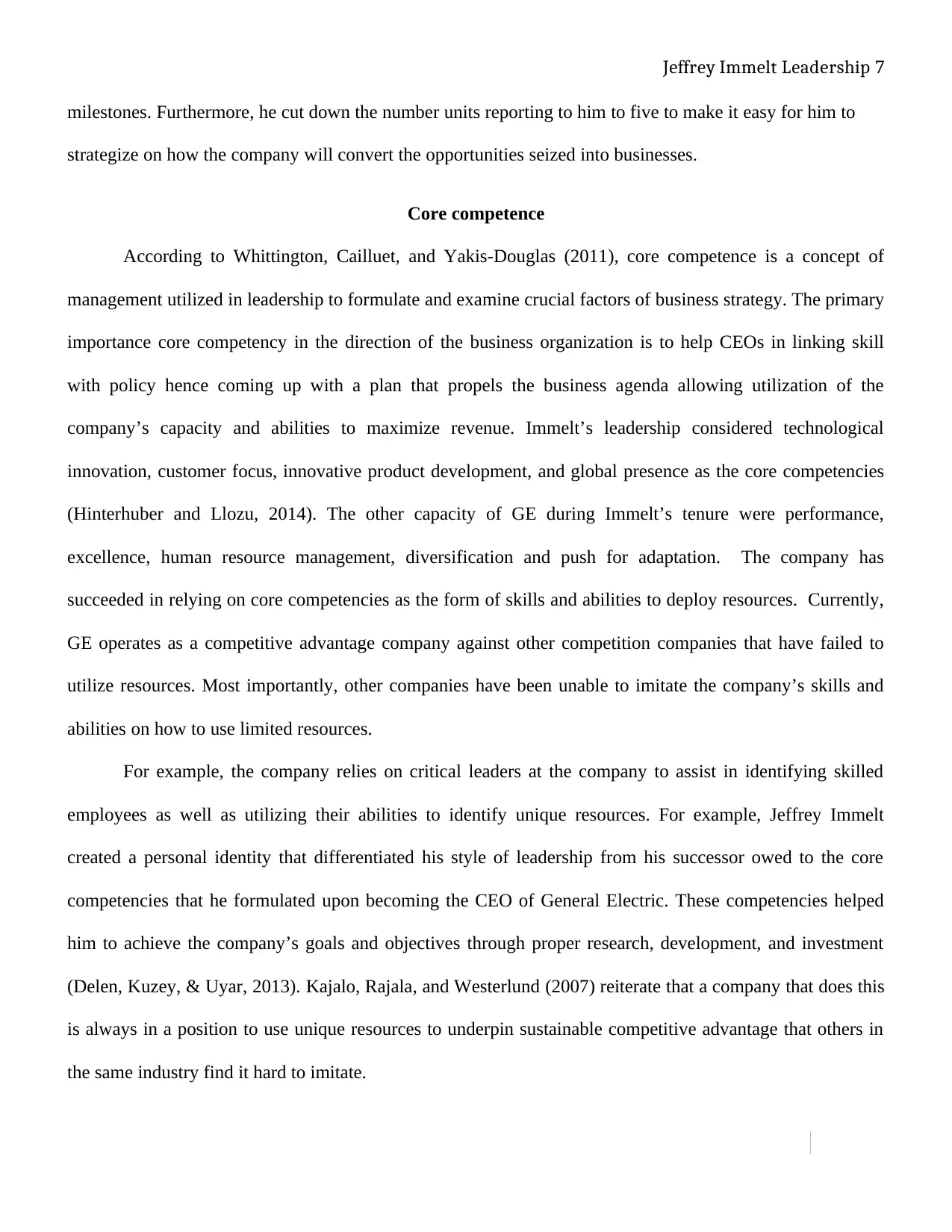
Jeffrey Immelt Leadership 7
milestones. Furthermore, he cut down the number units reporting to him to five to make it easy for him to
strategize on how the company will convert the opportunities seized into businesses.
Core competence
According to Whittington, Cailluet, and Yakis-Douglas (2011), core competence is a concept of
management utilized in leadership to formulate and examine crucial factors of business strategy. The primary
importance core competency in the direction of the business organization is to help CEOs in linking skill
with policy hence coming up with a plan that propels the business agenda allowing utilization of the
company’s capacity and abilities to maximize revenue. Immelt’s leadership considered technological
innovation, customer focus, innovative product development, and global presence as the core competencies
(Hinterhuber and Llozu, 2014). The other capacity of GE during Immelt’s tenure were performance,
excellence, human resource management, diversification and push for adaptation. The company has
succeeded in relying on core competencies as the form of skills and abilities to deploy resources. Currently,
GE operates as a competitive advantage company against other competition companies that have failed to
utilize resources. Most importantly, other companies have been unable to imitate the company’s skills and
abilities on how to use limited resources.
For example, the company relies on critical leaders at the company to assist in identifying skilled
employees as well as utilizing their abilities to identify unique resources. For example, Jeffrey Immelt
created a personal identity that differentiated his style of leadership from his successor owed to the core
competencies that he formulated upon becoming the CEO of General Electric. These competencies helped
him to achieve the company’s goals and objectives through proper research, development, and investment
(Delen, Kuzey, & Uyar, 2013). Kajalo, Rajala, and Westerlund (2007) reiterate that a company that does this
is always in a position to use unique resources to underpin sustainable competitive advantage that others in
the same industry find it hard to imitate.
milestones. Furthermore, he cut down the number units reporting to him to five to make it easy for him to
strategize on how the company will convert the opportunities seized into businesses.
Core competence
According to Whittington, Cailluet, and Yakis-Douglas (2011), core competence is a concept of
management utilized in leadership to formulate and examine crucial factors of business strategy. The primary
importance core competency in the direction of the business organization is to help CEOs in linking skill
with policy hence coming up with a plan that propels the business agenda allowing utilization of the
company’s capacity and abilities to maximize revenue. Immelt’s leadership considered technological
innovation, customer focus, innovative product development, and global presence as the core competencies
(Hinterhuber and Llozu, 2014). The other capacity of GE during Immelt’s tenure were performance,
excellence, human resource management, diversification and push for adaptation. The company has
succeeded in relying on core competencies as the form of skills and abilities to deploy resources. Currently,
GE operates as a competitive advantage company against other competition companies that have failed to
utilize resources. Most importantly, other companies have been unable to imitate the company’s skills and
abilities on how to use limited resources.
For example, the company relies on critical leaders at the company to assist in identifying skilled
employees as well as utilizing their abilities to identify unique resources. For example, Jeffrey Immelt
created a personal identity that differentiated his style of leadership from his successor owed to the core
competencies that he formulated upon becoming the CEO of General Electric. These competencies helped
him to achieve the company’s goals and objectives through proper research, development, and investment
(Delen, Kuzey, & Uyar, 2013). Kajalo, Rajala, and Westerlund (2007) reiterate that a company that does this
is always in a position to use unique resources to underpin sustainable competitive advantage that others in
the same industry find it hard to imitate.
Paraphrase This Document
Need a fresh take? Get an instant paraphrase of this document with our AI Paraphraser
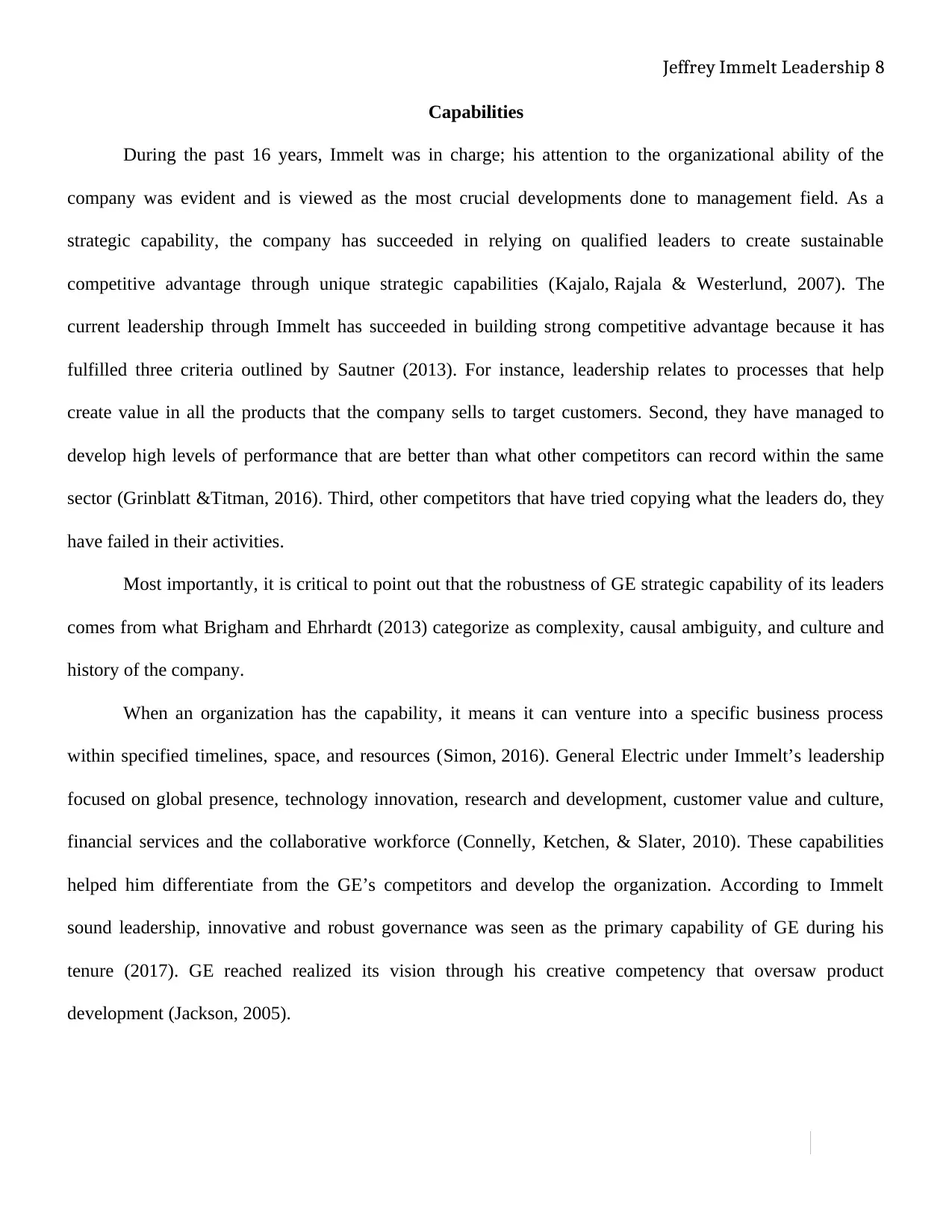
Jeffrey Immelt Leadership 8
Capabilities
During the past 16 years, Immelt was in charge; his attention to the organizational ability of the
company was evident and is viewed as the most crucial developments done to management field. As a
strategic capability, the company has succeeded in relying on qualified leaders to create sustainable
competitive advantage through unique strategic capabilities (Kajalo, Rajala & Westerlund, 2007). The
current leadership through Immelt has succeeded in building strong competitive advantage because it has
fulfilled three criteria outlined by Sautner (2013). For instance, leadership relates to processes that help
create value in all the products that the company sells to target customers. Second, they have managed to
develop high levels of performance that are better than what other competitors can record within the same
sector (Grinblatt &Titman, 2016). Third, other competitors that have tried copying what the leaders do, they
have failed in their activities.
Most importantly, it is critical to point out that the robustness of GE strategic capability of its leaders
comes from what Brigham and Ehrhardt (2013) categorize as complexity, causal ambiguity, and culture and
history of the company.
When an organization has the capability, it means it can venture into a specific business process
within specified timelines, space, and resources (Simon, 2016). General Electric under Immelt’s leadership
focused on global presence, technology innovation, research and development, customer value and culture,
financial services and the collaborative workforce (Connelly, Ketchen, & Slater, 2010). These capabilities
helped him differentiate from the GE’s competitors and develop the organization. According to Immelt
sound leadership, innovative and robust governance was seen as the primary capability of GE during his
tenure (2017). GE reached realized its vision through his creative competency that oversaw product
development (Jackson, 2005).
Capabilities
During the past 16 years, Immelt was in charge; his attention to the organizational ability of the
company was evident and is viewed as the most crucial developments done to management field. As a
strategic capability, the company has succeeded in relying on qualified leaders to create sustainable
competitive advantage through unique strategic capabilities (Kajalo, Rajala & Westerlund, 2007). The
current leadership through Immelt has succeeded in building strong competitive advantage because it has
fulfilled three criteria outlined by Sautner (2013). For instance, leadership relates to processes that help
create value in all the products that the company sells to target customers. Second, they have managed to
develop high levels of performance that are better than what other competitors can record within the same
sector (Grinblatt &Titman, 2016). Third, other competitors that have tried copying what the leaders do, they
have failed in their activities.
Most importantly, it is critical to point out that the robustness of GE strategic capability of its leaders
comes from what Brigham and Ehrhardt (2013) categorize as complexity, causal ambiguity, and culture and
history of the company.
When an organization has the capability, it means it can venture into a specific business process
within specified timelines, space, and resources (Simon, 2016). General Electric under Immelt’s leadership
focused on global presence, technology innovation, research and development, customer value and culture,
financial services and the collaborative workforce (Connelly, Ketchen, & Slater, 2010). These capabilities
helped him differentiate from the GE’s competitors and develop the organization. According to Immelt
sound leadership, innovative and robust governance was seen as the primary capability of GE during his
tenure (2017). GE reached realized its vision through his creative competency that oversaw product
development (Jackson, 2005).
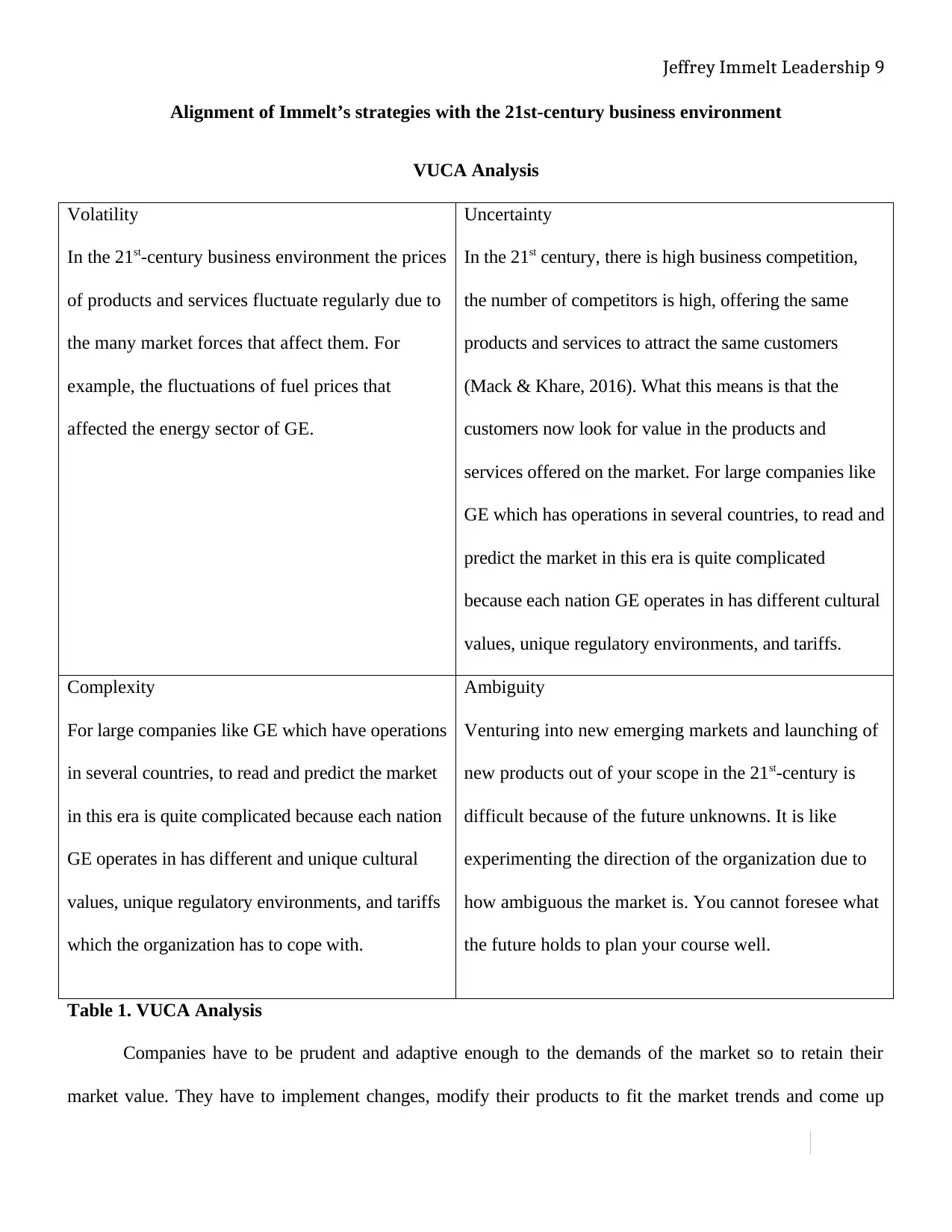
Jeffrey Immelt Leadership 9
Alignment of Immelt’s strategies with the 21st-century business environment
VUCA Analysis
Volatility
In the 21st-century business environment the prices
of products and services fluctuate regularly due to
the many market forces that affect them. For
example, the fluctuations of fuel prices that
affected the energy sector of GE.
Uncertainty
In the 21st century, there is high business competition,
the number of competitors is high, offering the same
products and services to attract the same customers
(Mack & Khare, 2016). What this means is that the
customers now look for value in the products and
services offered on the market. For large companies like
GE which has operations in several countries, to read and
predict the market in this era is quite complicated
because each nation GE operates in has different cultural
values, unique regulatory environments, and tariffs.
Complexity
For large companies like GE which have operations
in several countries, to read and predict the market
in this era is quite complicated because each nation
GE operates in has different and unique cultural
values, unique regulatory environments, and tariffs
which the organization has to cope with.
Ambiguity
Venturing into new emerging markets and launching of
new products out of your scope in the 21st-century is
difficult because of the future unknowns. It is like
experimenting the direction of the organization due to
how ambiguous the market is. You cannot foresee what
the future holds to plan your course well.
Table 1. VUCA Analysis
Companies have to be prudent and adaptive enough to the demands of the market so to retain their
market value. They have to implement changes, modify their products to fit the market trends and come up
Alignment of Immelt’s strategies with the 21st-century business environment
VUCA Analysis
Volatility
In the 21st-century business environment the prices
of products and services fluctuate regularly due to
the many market forces that affect them. For
example, the fluctuations of fuel prices that
affected the energy sector of GE.
Uncertainty
In the 21st century, there is high business competition,
the number of competitors is high, offering the same
products and services to attract the same customers
(Mack & Khare, 2016). What this means is that the
customers now look for value in the products and
services offered on the market. For large companies like
GE which has operations in several countries, to read and
predict the market in this era is quite complicated
because each nation GE operates in has different cultural
values, unique regulatory environments, and tariffs.
Complexity
For large companies like GE which have operations
in several countries, to read and predict the market
in this era is quite complicated because each nation
GE operates in has different and unique cultural
values, unique regulatory environments, and tariffs
which the organization has to cope with.
Ambiguity
Venturing into new emerging markets and launching of
new products out of your scope in the 21st-century is
difficult because of the future unknowns. It is like
experimenting the direction of the organization due to
how ambiguous the market is. You cannot foresee what
the future holds to plan your course well.
Table 1. VUCA Analysis
Companies have to be prudent and adaptive enough to the demands of the market so to retain their
market value. They have to implement changes, modify their products to fit the market trends and come up
⊘ This is a preview!⊘
Do you want full access?
Subscribe today to unlock all pages.

Trusted by 1+ million students worldwide
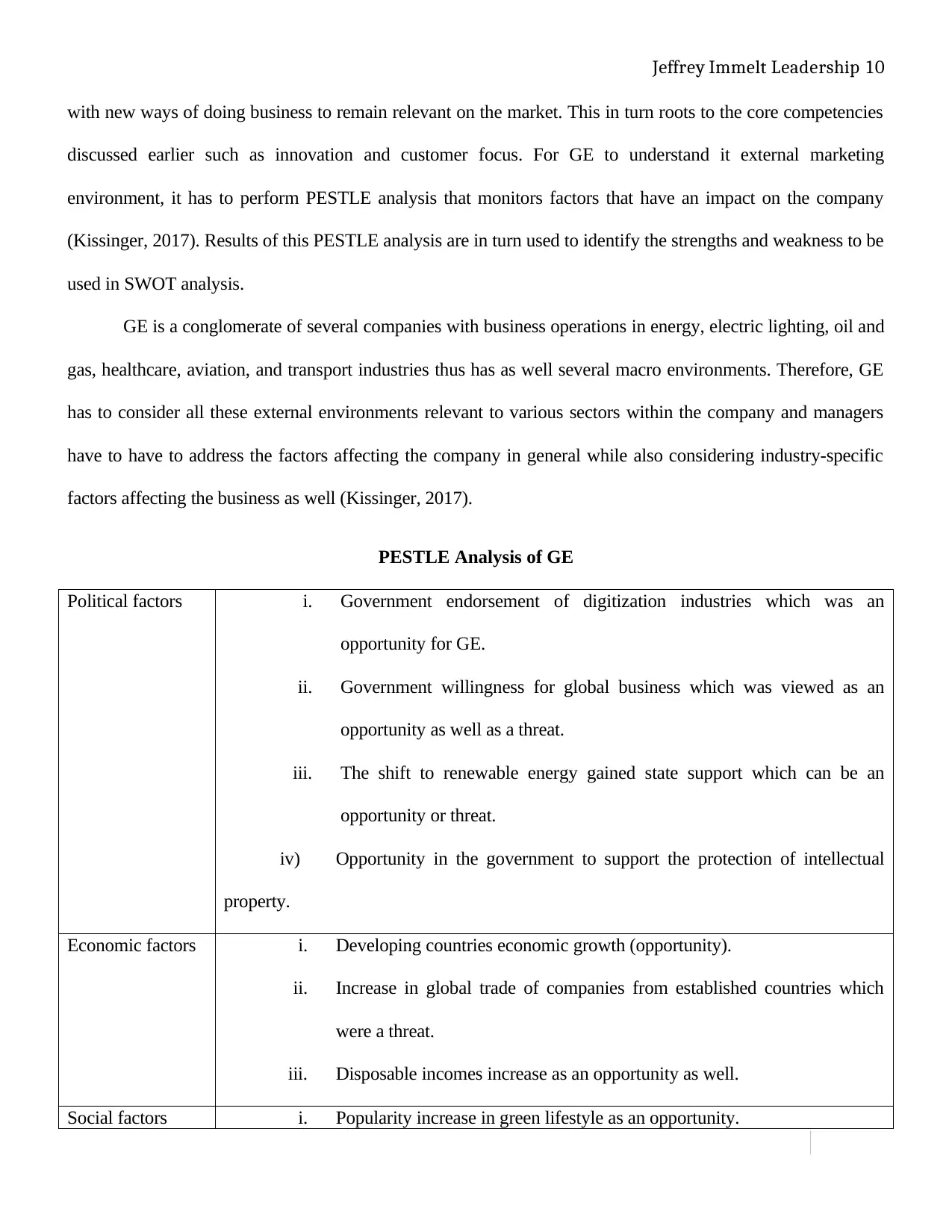
Jeffrey Immelt Leadership 10
with new ways of doing business to remain relevant on the market. This in turn roots to the core competencies
discussed earlier such as innovation and customer focus. For GE to understand it external marketing
environment, it has to perform PESTLE analysis that monitors factors that have an impact on the company
(Kissinger, 2017). Results of this PESTLE analysis are in turn used to identify the strengths and weakness to be
used in SWOT analysis.
GE is a conglomerate of several companies with business operations in energy, electric lighting, oil and
gas, healthcare, aviation, and transport industries thus has as well several macro environments. Therefore, GE
has to consider all these external environments relevant to various sectors within the company and managers
have to have to address the factors affecting the company in general while also considering industry-specific
factors affecting the business as well (Kissinger, 2017).
PESTLE Analysis of GE
Political factors i. Government endorsement of digitization industries which was an
opportunity for GE.
ii. Government willingness for global business which was viewed as an
opportunity as well as a threat.
iii. The shift to renewable energy gained state support which can be an
opportunity or threat.
iv) Opportunity in the government to support the protection of intellectual
property.
Economic factors i. Developing countries economic growth (opportunity).
ii. Increase in global trade of companies from established countries which
were a threat.
iii. Disposable incomes increase as an opportunity as well.
Social factors i. Popularity increase in green lifestyle as an opportunity.
with new ways of doing business to remain relevant on the market. This in turn roots to the core competencies
discussed earlier such as innovation and customer focus. For GE to understand it external marketing
environment, it has to perform PESTLE analysis that monitors factors that have an impact on the company
(Kissinger, 2017). Results of this PESTLE analysis are in turn used to identify the strengths and weakness to be
used in SWOT analysis.
GE is a conglomerate of several companies with business operations in energy, electric lighting, oil and
gas, healthcare, aviation, and transport industries thus has as well several macro environments. Therefore, GE
has to consider all these external environments relevant to various sectors within the company and managers
have to have to address the factors affecting the company in general while also considering industry-specific
factors affecting the business as well (Kissinger, 2017).
PESTLE Analysis of GE
Political factors i. Government endorsement of digitization industries which was an
opportunity for GE.
ii. Government willingness for global business which was viewed as an
opportunity as well as a threat.
iii. The shift to renewable energy gained state support which can be an
opportunity or threat.
iv) Opportunity in the government to support the protection of intellectual
property.
Economic factors i. Developing countries economic growth (opportunity).
ii. Increase in global trade of companies from established countries which
were a threat.
iii. Disposable incomes increase as an opportunity as well.
Social factors i. Popularity increase in green lifestyle as an opportunity.
Paraphrase This Document
Need a fresh take? Get an instant paraphrase of this document with our AI Paraphraser
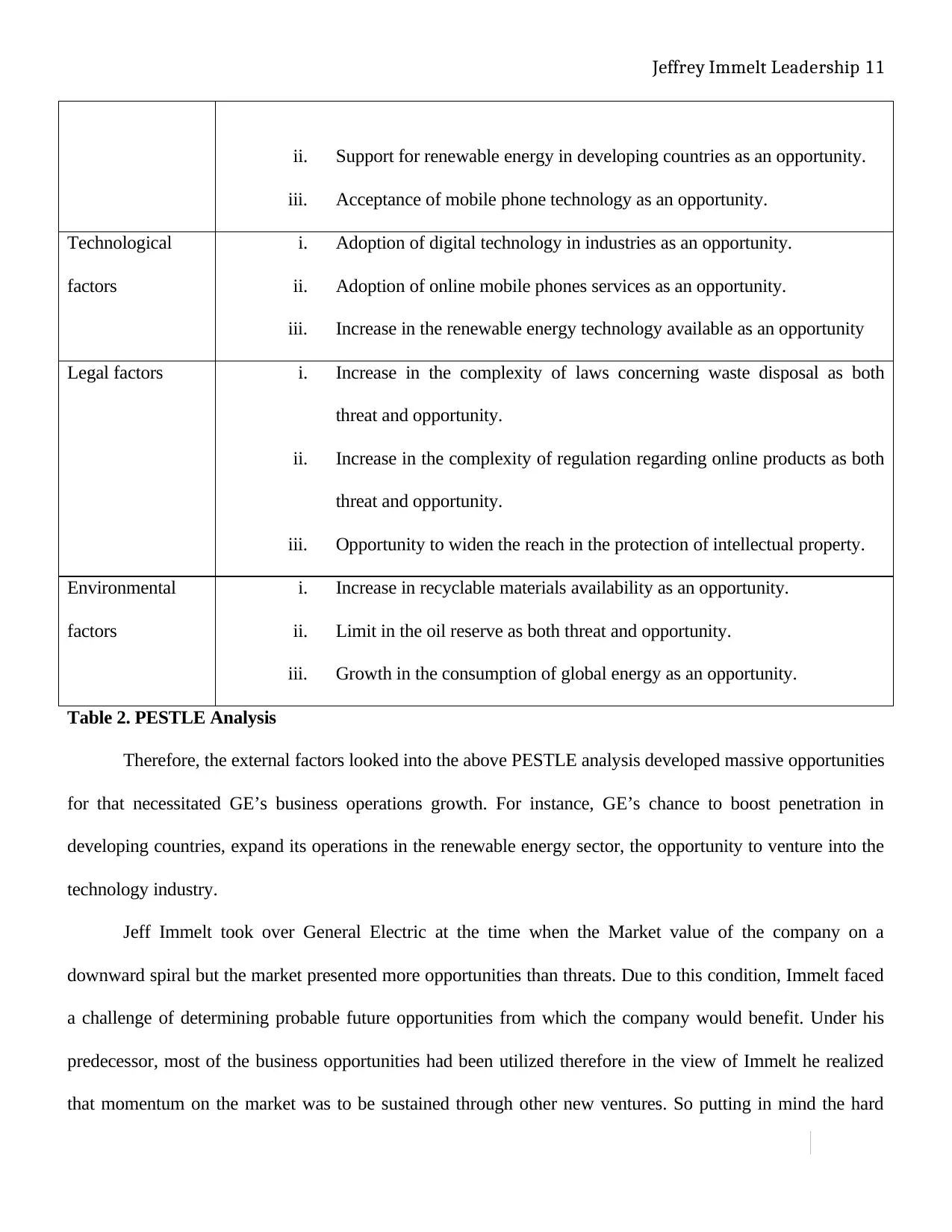
Jeffrey Immelt Leadership 11
ii. Support for renewable energy in developing countries as an opportunity.
iii. Acceptance of mobile phone technology as an opportunity.
Technological
factors
i. Adoption of digital technology in industries as an opportunity.
ii. Adoption of online mobile phones services as an opportunity.
iii. Increase in the renewable energy technology available as an opportunity
Legal factors i. Increase in the complexity of laws concerning waste disposal as both
threat and opportunity.
ii. Increase in the complexity of regulation regarding online products as both
threat and opportunity.
iii. Opportunity to widen the reach in the protection of intellectual property.
Environmental
factors
i. Increase in recyclable materials availability as an opportunity.
ii. Limit in the oil reserve as both threat and opportunity.
iii. Growth in the consumption of global energy as an opportunity.
Table 2. PESTLE Analysis
Therefore, the external factors looked into the above PESTLE analysis developed massive opportunities
for that necessitated GE’s business operations growth. For instance, GE’s chance to boost penetration in
developing countries, expand its operations in the renewable energy sector, the opportunity to venture into the
technology industry.
Jeff Immelt took over General Electric at the time when the Market value of the company on a
downward spiral but the market presented more opportunities than threats. Due to this condition, Immelt faced
a challenge of determining probable future opportunities from which the company would benefit. Under his
predecessor, most of the business opportunities had been utilized therefore in the view of Immelt he realized
that momentum on the market was to be sustained through other new ventures. So putting in mind the hard
ii. Support for renewable energy in developing countries as an opportunity.
iii. Acceptance of mobile phone technology as an opportunity.
Technological
factors
i. Adoption of digital technology in industries as an opportunity.
ii. Adoption of online mobile phones services as an opportunity.
iii. Increase in the renewable energy technology available as an opportunity
Legal factors i. Increase in the complexity of laws concerning waste disposal as both
threat and opportunity.
ii. Increase in the complexity of regulation regarding online products as both
threat and opportunity.
iii. Opportunity to widen the reach in the protection of intellectual property.
Environmental
factors
i. Increase in recyclable materials availability as an opportunity.
ii. Limit in the oil reserve as both threat and opportunity.
iii. Growth in the consumption of global energy as an opportunity.
Table 2. PESTLE Analysis
Therefore, the external factors looked into the above PESTLE analysis developed massive opportunities
for that necessitated GE’s business operations growth. For instance, GE’s chance to boost penetration in
developing countries, expand its operations in the renewable energy sector, the opportunity to venture into the
technology industry.
Jeff Immelt took over General Electric at the time when the Market value of the company on a
downward spiral but the market presented more opportunities than threats. Due to this condition, Immelt faced
a challenge of determining probable future opportunities from which the company would benefit. Under his
predecessor, most of the business opportunities had been utilized therefore in the view of Immelt he realized
that momentum on the market was to be sustained through other new ventures. So putting in mind the hard
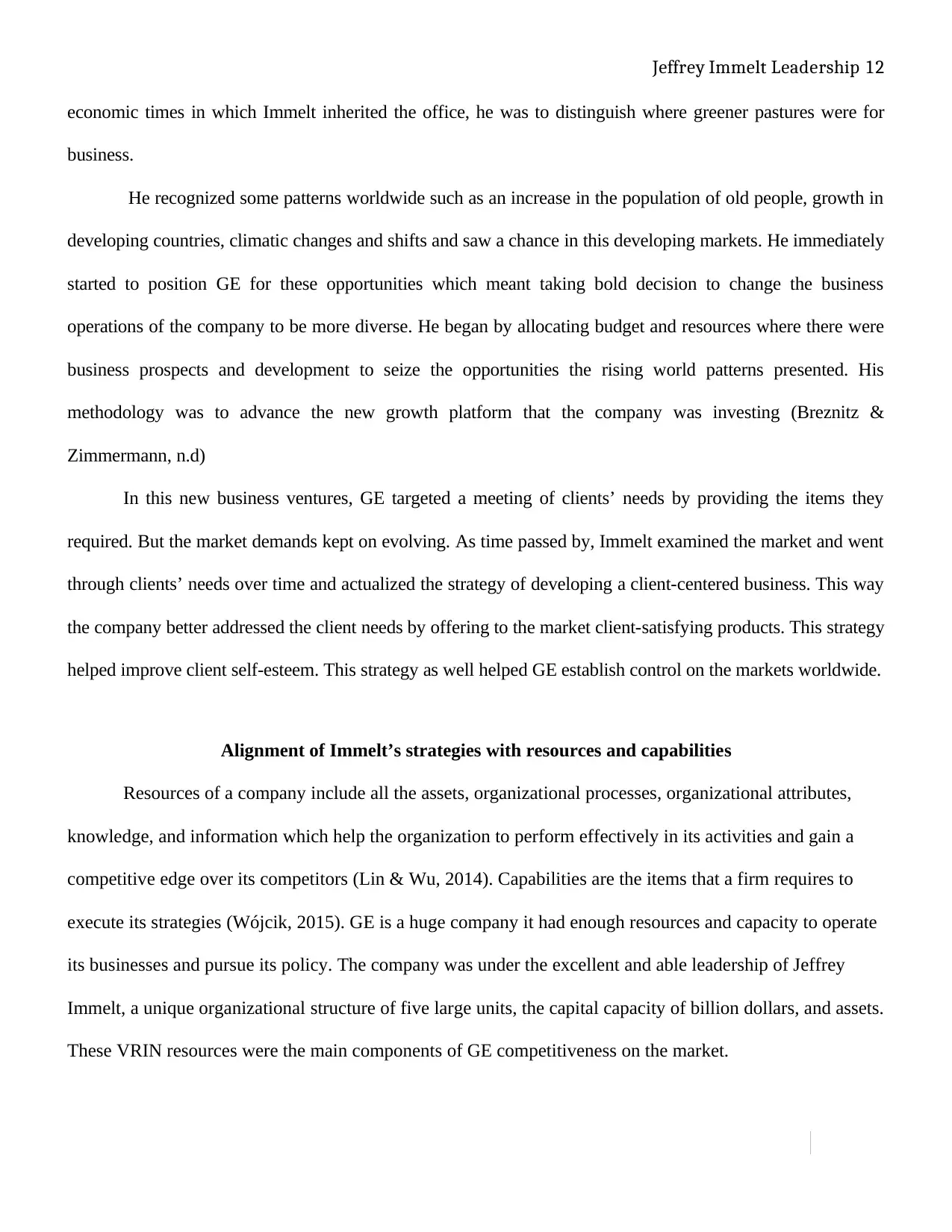
Jeffrey Immelt Leadership 12
economic times in which Immelt inherited the office, he was to distinguish where greener pastures were for
business.
He recognized some patterns worldwide such as an increase in the population of old people, growth in
developing countries, climatic changes and shifts and saw a chance in this developing markets. He immediately
started to position GE for these opportunities which meant taking bold decision to change the business
operations of the company to be more diverse. He began by allocating budget and resources where there were
business prospects and development to seize the opportunities the rising world patterns presented. His
methodology was to advance the new growth platform that the company was investing (Breznitz &
Zimmermann, n.d)
In this new business ventures, GE targeted a meeting of clients’ needs by providing the items they
required. But the market demands kept on evolving. As time passed by, Immelt examined the market and went
through clients’ needs over time and actualized the strategy of developing a client-centered business. This way
the company better addressed the client needs by offering to the market client-satisfying products. This strategy
helped improve client self-esteem. This strategy as well helped GE establish control on the markets worldwide.
Alignment of Immelt’s strategies with resources and capabilities
Resources of a company include all the assets, organizational processes, organizational attributes,
knowledge, and information which help the organization to perform effectively in its activities and gain a
competitive edge over its competitors (Lin & Wu, 2014). Capabilities are the items that a firm requires to
execute its strategies (Wójcik, 2015). GE is a huge company it had enough resources and capacity to operate
its businesses and pursue its policy. The company was under the excellent and able leadership of Jeffrey
Immelt, a unique organizational structure of five large units, the capital capacity of billion dollars, and assets.
These VRIN resources were the main components of GE competitiveness on the market.
economic times in which Immelt inherited the office, he was to distinguish where greener pastures were for
business.
He recognized some patterns worldwide such as an increase in the population of old people, growth in
developing countries, climatic changes and shifts and saw a chance in this developing markets. He immediately
started to position GE for these opportunities which meant taking bold decision to change the business
operations of the company to be more diverse. He began by allocating budget and resources where there were
business prospects and development to seize the opportunities the rising world patterns presented. His
methodology was to advance the new growth platform that the company was investing (Breznitz &
Zimmermann, n.d)
In this new business ventures, GE targeted a meeting of clients’ needs by providing the items they
required. But the market demands kept on evolving. As time passed by, Immelt examined the market and went
through clients’ needs over time and actualized the strategy of developing a client-centered business. This way
the company better addressed the client needs by offering to the market client-satisfying products. This strategy
helped improve client self-esteem. This strategy as well helped GE establish control on the markets worldwide.
Alignment of Immelt’s strategies with resources and capabilities
Resources of a company include all the assets, organizational processes, organizational attributes,
knowledge, and information which help the organization to perform effectively in its activities and gain a
competitive edge over its competitors (Lin & Wu, 2014). Capabilities are the items that a firm requires to
execute its strategies (Wójcik, 2015). GE is a huge company it had enough resources and capacity to operate
its businesses and pursue its policy. The company was under the excellent and able leadership of Jeffrey
Immelt, a unique organizational structure of five large units, the capital capacity of billion dollars, and assets.
These VRIN resources were the main components of GE competitiveness on the market.
⊘ This is a preview!⊘
Do you want full access?
Subscribe today to unlock all pages.

Trusted by 1+ million students worldwide
1 out of 22
Related Documents
Your All-in-One AI-Powered Toolkit for Academic Success.
+13062052269
info@desklib.com
Available 24*7 on WhatsApp / Email
![[object Object]](/_next/static/media/star-bottom.7253800d.svg)
Unlock your academic potential
Copyright © 2020–2025 A2Z Services. All Rights Reserved. Developed and managed by ZUCOL.





